If Pinterest only means cookie recipes and bathroom remodel ideas to you, you’re missing out. Talking about the importance of visual content is one thing. To understand what matters is a completely different one.
Companies (and self-employed) who are successful with it do two things: They produce visual content in a targeted way to generate attention and generate traffic, or they have visuals firmly integrated into their content strategy and work sustainably.
In this article, we do not want to develop such a strategy but to approach it more pragmatically and look explicitly at Pinterest. Because while everyone focuses on Instagram and, increasingly, Snapchat, Pinterest is becoming more and more attractive in our eyes.
Precisely because the competition there is not (yet) so big, but also because the use of the platform has positive effects on other areas of content marketing (SEO, social media, etc.).
Let’s take a look at what Pinterest has to offer and how you can benefit from it.
Pinterest Is Different and Better in Many Ways
In the shadow of Facebook, Instagram, and others, Pinterest – as a research tool and a content channel – has developed into a relevant platform for content marketing. Pinterest has become the perfect platform for marketers and primarily serves them.
Pinterest is a catalog of ideas. I think that’s a very different thing than a social network. On a social network, you upload photos for other people to like. Pinterest, on the other hand, is self-serving.
– Ben Silbermann (CEO of Pinterest)
Silbermann could not have characterized his platform more accurately.
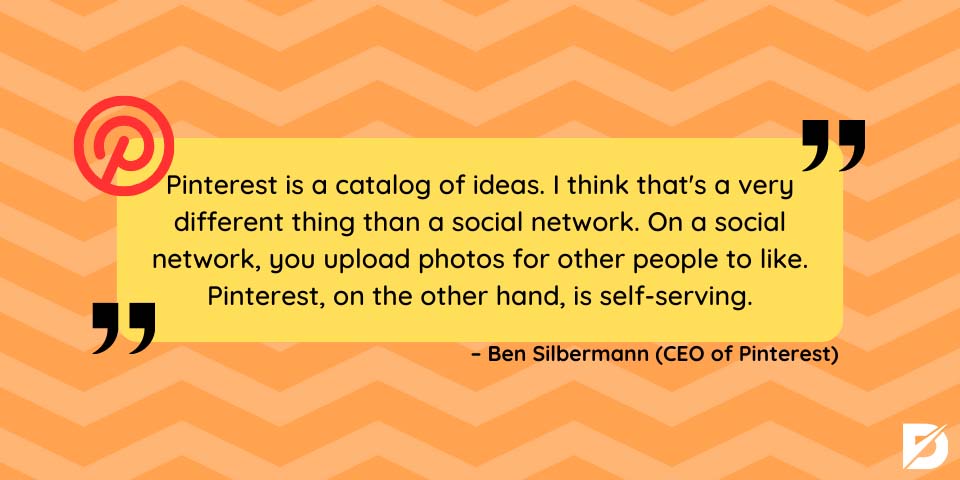
Pinterest has become a place of inspiration for around 335 million users worldwide (as of 2019/Q4). Their motto is “Discover instead of search.” Everyone is looking for new ideas but also sharing their own. According to their statements, there are now over 100 billion in number. Everyone who participates uploads their suitable images and contributes to the “value” of the platform.
“Consumers use Pinterest to curate their vision of their ideal self.”
The “Beauty” of Pinterest Is
- Personalization (from a user perspective) – On one hand, Pinterest makes content recommendations based on your activities within the platform (likes, comments, repins, etc.). On the other, you can allow Pinterest to take your activities on other websites into account to clarify these recommendations. This relates to your use of “Pint it” buttons on sites and the data circulating in the advertising network. In addition, there is, of course, the possibility to create your boards and curate content thematically.
- The possibility of directing users to their website (from the marketers’ point of view) – Each Pin is (ideally) provided with a corresponding backlink so that users can consume further content with a simple click. Provided, of course, that the link does not lead to your homepage but to a thematically appropriate “content page.” The backlinks are not necessarily the best thing about Pinterest. According to studies and data from Pinterest, 96% of active users use the platform for general research and an impressive 93% plan future purchases. The fact that 87% of the users buy speaks for Pinterest’s influence on the customer journey and, ultimately, for the purchase decision. 72% of users were even introduced to new brands through Pinterest.
Pinterest SEO Tips
We agree that a more extended look at Pinterest is worth it, right?! Well, then, let’s take a look at what we should pay attention to.
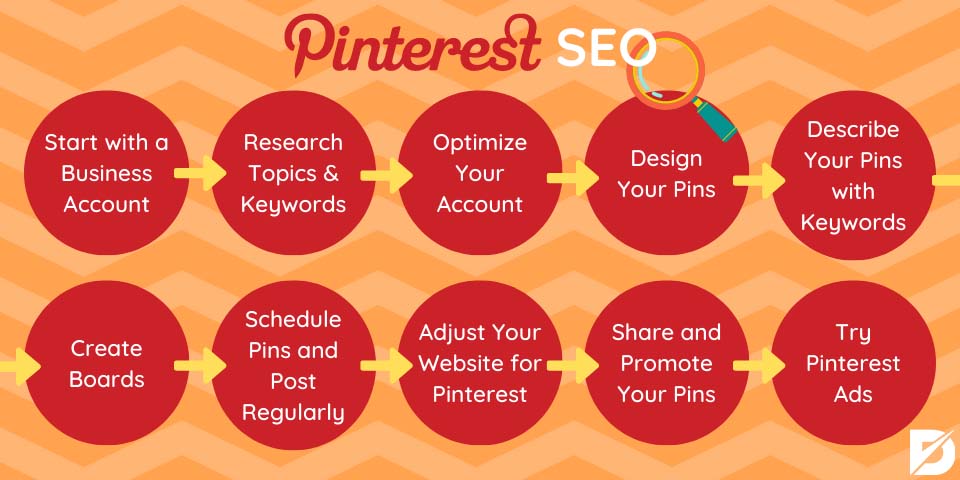
Start with a Business Account
You need to start with basic steps like creating a business account. You can create a business account on Pinterest for free. When you create a business account, it is possible to benefit from some features like Pinterest Analytics. Don’t worry if you have an existing account; you can convert it to a business account from settings.
Research Topics & Keywords
“It is important that the user intention for the selected keyword/topic is based on an image search,” says Fion Kientzler, Managing Partner at Suxeedo. “Images from Pinterest also often appear in Google Image Search, which should be taken into account when describing the image with appropriate keywords.”
The typical approach how to do keyword research also works for Pinterest:
- Brainstorm keywords
- Complement ideas using Google Keyword Planner
- Check keywords for search volume and competition
- Identify “valuable” keywords
However, this method is based on searches via Google, and Fionn warns:
“There are subject areas that work excellently on Pinterest, such as living, decoration, or fashion. With these topics, you don’t have to do the keyword analysis as meticulously for the search engine. It is more about defining categories and subcategories for the browsing of the user.”
It is, therefore, worthwhile to enter the keywords directly into Pinterest in the search slot.
Even before you start the search, you will receive suggestions similar to Google – not just search terms but also matching accounts and boards. This opens up further research sources!
After you have started the search, you will see countless pins. From now on, it will be exciting because you have to look closely:
- What kind of content do you see? Can you deduce what users expect from the search using the respective search terms?
- How much content do you play? Do you find thematic gaps that you could fill?
- Where does the content come from? People or brands? How strong is the competition?
- How “popular” is this content (with a view to likes, repins, comments, etc.)? Can you deliver better content – in terms of content or design? If you have answered all of these questions, you will have refined your keyword list on the one hand, and on the other hand, you will have a good sense of how you can best implement your content ideas.
But Wait, There’s More!
You may have noticed the search suggestions directly below the search field. This is Pinterest’s “Guided Search”. Like the end of the Google search results page, Pinterest also makes suggestions for further search terms. If there are new ones here, you should also take a closer look at them.
Insider Tip: Keyword Research via Boards. If you have created your keyword list in the classic sense, use it to create a new board. Pinterest then spits out similar/relevant suggestions that you can use for your boards or descriptions (see screenshot). Admittedly, I accidentally came across it, but that’s what makes it so interesting. Because I have never read about it anywhere, you could also use the Pinterest Keyword Tool or Pinterested tool, which is specially developed by Kitchen Stories CMO Szymon Wilkosz.
So far, so good. Now, it’s time to use our keywords. This mainly concerns the design and description of individual pins, but we can use them beforehand to describe our boards.
Optimize Your Account
After creating an account and keyword research, you should optimize your account for search engines. Besides that, your account profile represents your brand to your audience. Here are the steps to optimize your profile.
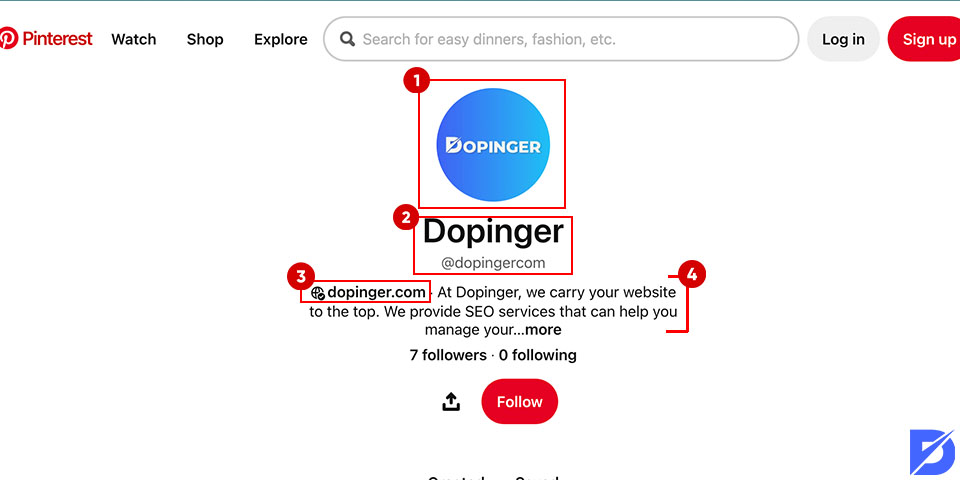
- Choose Your Profile Photo: Your profile photo should represent your business, blog or etc. It can be your brand logo or something else, but the crucial thing is that don’t forget to use high-quality photos. Also, it should be square to crop properly.
- Choose a name and username: You need to choose an SEO-friendly name, and it is important to use a descriptive name.
- Website link: You should give your website link to make it easier to reach your website.
- Write your bio: Descriptive and SEO-friendly bio will make your bio effective. This is the place where you will explain who you are. Don’t forget that there is 500 character limit.
Design Your Pins
The design is not a classic “SEO factor,” but the more appealing your content is, the more users will interact with it – and that is a ranking factor.
If I had to reduce it to the essentials, I would recommend that you focus on a consistent and recognizable (corporate) design and optimize your content for viewing on mobile devices. In this regard, the same rules apply to your website or blog, Facebook, Twitter, and all other social media.
Use a vertical picture format (at least 2:3 aspect ratio) for your pins, use meaningful pictures, and use as little text as possible. Pay attention to the size of the text that is easy to read on your smartphone. In addition, you should use eye-catching colors to have more effective pins. It is important to show your content is valuable to read. The pin and content should be relevant to get shown on the feed according to the search terms.
Describe Your Pins with Keywords
After the visual impression, descriptions are the second important element – so that your content can be found. This is where your keywords come in:
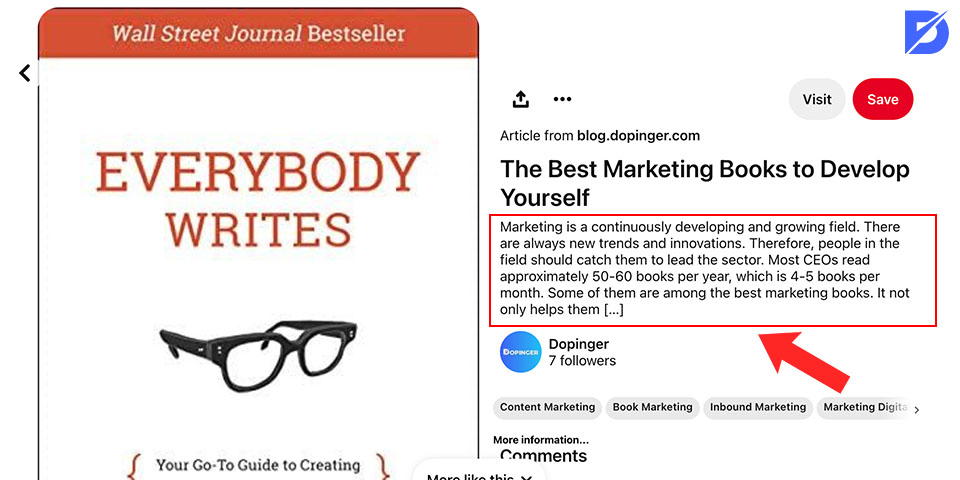
- Include them in the title of your pins.
- Make sure to include them in the title of the linked content (e.g., your blog articles), as this is also displayed via rich pins.
- Use them in the picture descriptions on your website (alt tags) because these are adopted when pinning via the “Pin it” button and are not always changed by the user.
- Name image files using keywords (e.g., “pinterest-seo-board.png”).
- Describe your pins using (longtail) keywords. According to Dan Zarrella’s analysis, the ideal length of your description is between 200 and 310 characters.
Remarks: Despite all the need for keywords, you should not do any keyword stuffing and use as many search terms as possible for the better. Always remember the user’s search behavior and use synonyms or paraphrases if necessary. Often, the user does not know which keyword would be the right one for him. Incidentally, keyword hashtags are of little relevance to Pinterest. They are only clickable in descriptions and then basically lead to the same search results as the search for the same word without the hashtag. They only make sense if they are used in campaigns and are used for assignments.
Create Boards
You don’t have to have many boards, but you should have at least one board. While creating a board, the most important part is choosing a name for the board. Instead of general names, you can use niche names. Let’s say you have a blog for reviewing books. You can create a board as “book recommendations.” However, using “book recommendations for university students” would be better. After creating boards, every pin should be relevant to the board.
Schedule Pins and Post Regularly
The ideal sharing time of each social media platform is different. That’s why you must be careful about posting time on Pinterest. After analyzing the best time to get more engagement on Pinterest, you can schedule your posts so as not to miss the ideal times because posting regularly is essential to have SEO friendly profile. Only in this way can you convince the algorithm and ensure your profile will be on the Discover page.
Adjust Your Website for Pinterest
You create your Pinterest account to be findable on Pinterest and search engines. So why not make your Pinterest account easy to find on your website? Add save buttons, link to your Pinterest account, and share buttons for Pinterest. Also, verify your website to add your profile picture to your pins.
Share and Promote Your Pins
Similar to other platforms, Pinterest marketing lives from consistency and frequency. Only those who regularly share good content will be successful in the long term. Adobe recommends four to ten pins a day; other sources, such as buffers, even recommend up to 30 a day.
We usually only get this number through repins since we cannot produce as much content ourselves. The more of our content we can contribute, the better, but anyway, it is good form to appreciate the work of other users. The more you interact with others, the more they are likely to interact with you.
If there are “pinfluencers” in your area, you should build good relationships with them. They can help you with the distribution of your pictures and support you in building the brand as a whole. So think carefully about how you want to retaliate for it. Besides, you could try the following tips to promote your Pinterest content:
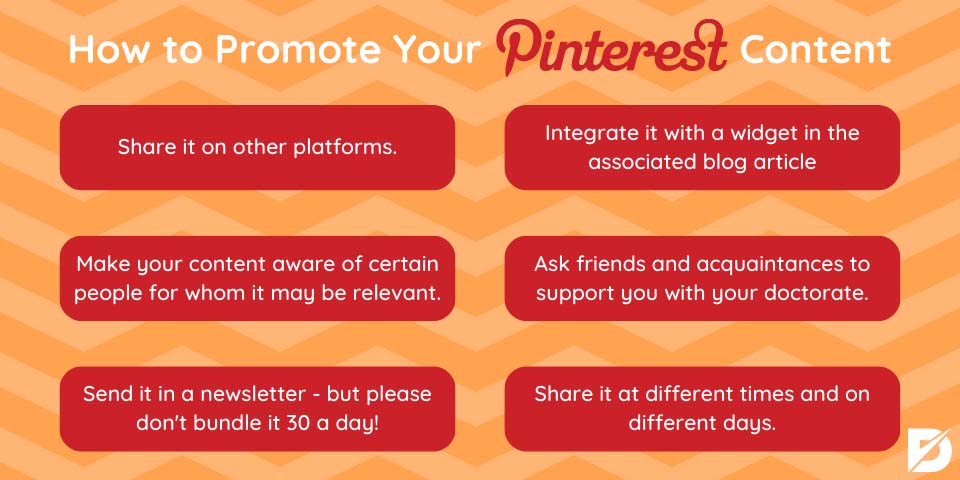
- Share it on other platforms (e.g., Facebook, Twitter).
- Integrate it with a widget in the associated blog article so that readers are aware of your Pinterest account.
- Make your content aware of certain people for whom it may be relevant.
- Ask friends and acquaintances to support you with your doctorate.
- Send it in a newsletter – but please don’t bundle it 30 a day!
- Share it at different times and on different days.
Try Pinterest Ads
Pinterest Ads (also known as “Promoted Pins”), as the name suggests, are “regular” contents that advertisers have in terms of reach and interaction (likes, repins, comments), traffic to your website, or app installations. For targeting, we can filter by keywords, interests, categories (own pinterests), location, language, gender, and device or upload a custom target group. Similar to Google AdWords or Facebook, a CPM or CPC is used for billing. A big advantage of ads is that we can compare content and define success criteria even more precisely. And while we are talking about money and performance, one last aspect must not be missing: measuring success.
Pinterest Analytics and Additional Pinterest Tools
With Pinterest’s business variant, you get an extensive analytics tool to measure your reach, interaction, and activity. The all-time function also gives you an overview of your most successful content. In contrast, the people-you-reach feature gives you information about your visitors’ demographic aspects and interests.
It’s Your Turn: Use Pinterest to Get a Head Start!
Do it like Springlane and get a head start by using Pinterest. The “Online Shop for Kitchen and Pleasure” achieve over 400 million content impressions per month with its Pinterest account – even though it “only” has just under 120,000 followers! The team behind their success relies, among other things, on rich pins for recipes but also pays attention to producing predominantly content that can be distributed via several channels.
“For this, we use a “Sharable” version at Pinterest and a standard article image. Among other things, this has an optimized image size and an eye-catching text overlay. We also use corresponding metadata (rich pins for recipes).”
– Thomas Hefke, Head of Content Marketing
That’s what I meant by “sustainable” and “positive effects on other areas of content marketing”. For example, in comparison to Instagram, content is prepared exclusively for Pinterest but not exclusively designed and produced for it. This is a huge difference because it makes use of -emphasis on “value”- we suddenly find content ideas several times.
And you know what positive (SEO) effects result from it. All Springlane pins are linked to the online magazine or recipes, some even directly to the shop. In any case, they all permanently ensure new visitors.
It is crucial that the content complements each other and not twice! While the images, for example, tease a dish (and thus do justice to Pinterest’s inspirational character), the website provides the user with detailed cooking instructions or general kitchen tips. Pinterest now generates more traffic than any other Springlane social media channel. Practical that through this tandem, they have enough usable content to use other platforms, i.e., Facebook. That’s what I call a holistic concept!
Conclusion: Accelerate Your Business With Pinterest
Pinterest is one of the best website traffic sources, and some online brands confirm this. For this reason, many companies want to find out more about how Pinterest works. If you want to achieve real growth and see Pinterest as a possible solution, you must commit yourself to designing Pins that induce people to click on them. With the tips discussed in this article, you can optimize your pins for clicks and increase traffic on your website.
Frequently Asked Questions About
According to some studies, deleting Pins with few re-shares can increase the quality of the Pinterest account. On the other hand, pins are not performing today but may have remained viral for months or years before. And they can cause you thousands of visitors. So it all depends on your choice.
Many bloggers and website owners don’t know much about Pinterest. As a result, many fantastic and interesting articles are “disassembled” from poor and keyword-free descriptions.It certainly takes time to write a good description for each pin, but for a blogger or a brand that wants to invest in Pinterest, it is very important and will lead to results. A good description for both the Pin and Repin leads to an improvement in your pin’s quality to get more Repins. Try yourself and see your results so that you can evaluate them against the time invested.
Until recently, Pinterest was an anti-hashtag platform. However, hashtags are accepted today, but Pinterest still recommends not using more than 20 per pin. You can click and search hashtags, but unlike other Pinterest content, search results based on hashtags show the pin in chronological order rather than starting from the best.
How can you make sure that optimized descriptions are used by users when they post your blog posts? You can consider setting up your blog on WordPress. There you will have the chance to use plug-ins like Social Warfare to make sure that the description and image in your blog post are used by users when they download the post. Alternatively, if you don’t use a plug-in, add the description to the alt-text of the image.
Yes, you should conduct keyword research for Pinterest SEO. The keywords you use will be used in bio, pin descriptions, and board names to be more visible on Pinterest searches.





No comments to show.